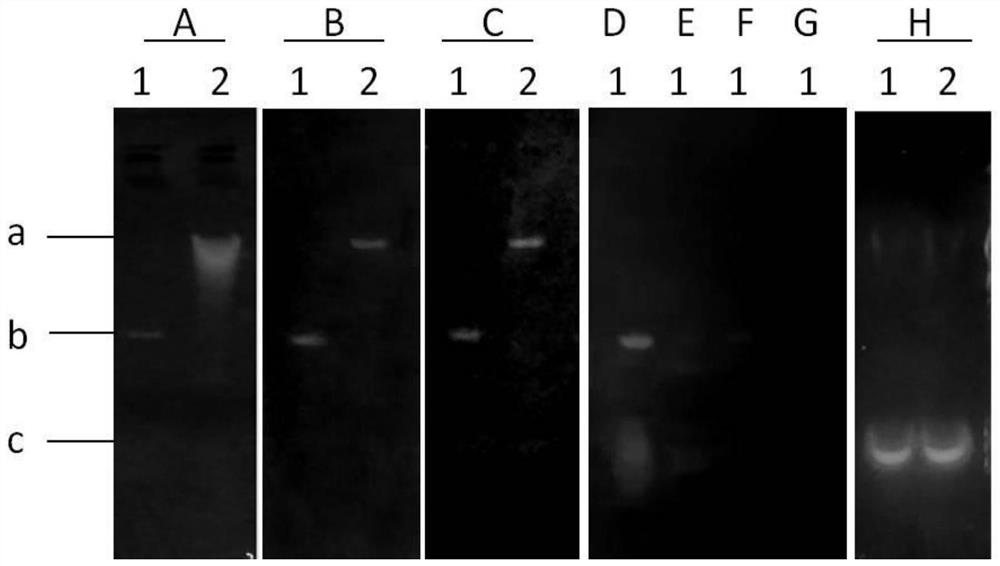Kit and method for extracting bacterial plasmids by alkali lysis method
A technology of bacterial plasmids and kits, applied in biochemical equipment and methods, microbial measurement/inspection, DNA preparation, etc., can solve the problems of inability to use sequencing and enzyme digestion, short time-consuming, easy failure, etc., to meet the requirements of sequencing and enzyme digestion operations, reducing contact time, and long storage time
- Summary
- Abstract
- Description
- Claims
- Application Information
AI Technical Summary
Problems solved by technology
Method used
Image
Examples
Embodiment 1
[0031] 1. The composition of reagents for extracting bacterial plasmids:
[0032] Bacterial suspension: 50mmol / L glucose, 10mmol / L EDTA, 20mmol / L Tris-HCl, 1.5mol / LLiCl, 0.5mol / L NH 4 Ac, solution pH 8.0;
[0033] Bacterial lysate: 0.2mol / L NaOH, 1% SDS;
[0034] Plasmid renaturation solution: 0.8mol / L KAc and 3.5mol / L guanidine isothiocyanate, pH 4.8;
[0035] Washing solution: 70% ethanol in water.
[0036] 2. The method of extracting the recombinant plasmid and pBI121-EGFP plasmid connecting pGM-T and the target gene with the reagent described in step 1:
[0037] 1) Take 1 mL of Escherichia coli DH5α culture solution in a 1.5 mL centrifuge tube, centrifuge at 12,000 r / min for 1 min, remove the supernatant, and retain the precipitate;
[0038] 2) Add 150 μL of bacterial suspension to the centrifuge tube and place it on a shaker to fully suspend the bacterial pellet;
[0039] 3) Add 250 μL of bacterial lysate to the bacterial suspension, invert the centrifuge tube 5 time...
Embodiment 2
[0049] 1. The composition of reagents for extracting bacterial plasmids:
[0050] Bacterial suspension: 120mmol / L glucose, 30mmol / L EDTA, 30mmol / L Tris-HCl, 3.0mol / LLiCl, 1.5mol / L NH 4 Ac, solution pH 8.0;
[0051] Bacterial lysate: 0.2mol / L NaOH, 1% SDS;
[0052] Plasmid renaturation solution: 3mol / L KAc and 4.5mol / L guanidine isothiocyanate, pH 4.8;
[0053] Washing solution: 80% ethanol in water.
[0054] 2. The method of extracting the recombinant plasmid and pBI121-EGFP plasmid connecting pGM-T and the target gene with the reagent described in step 1:
[0055] 1) Take Escherichia coli DH5α culture medium in a 1.5mL centrifuge tube, centrifuge at 12000r / min for 1min, remove the supernatant, and keep the precipitate; then add 1.5mL of Escherichia coli DH5α culture medium to the same centrifuge tube, centrifuge at 12000r / min for 1min , remove the supernatant and keep the precipitate;
[0056] 2) Add 370 μL of bacterial suspension to the centrifuge tube and place it on a...
Embodiment 3
[0067] 1. The composition of reagents for extracting bacterial plasmids:
[0068] Bacterial suspension: 100mmol / L glucose, 20mmol / L EDTA, 25mmol / L Tris-HCl, 2.5mol / LLiCl, 1.0mol / L NH 4 Ac, solution pH 8.0;
[0069] Bacterial lysate: 0.2mol / L NaOH, 1% SDS;
[0070] Plasmid renaturation solution: 1.0mol / L KAc and 4.0mol / L guanidine isothiocyanate, pH 4.8;
[0071] Washing solution: 80% ethanol in water.
[0072] 2. The method of extracting the recombinant plasmid and pBI121-EGFP plasmid connecting pGM-T and the target gene with the reagent described in step 1:
[0073] 1) Take 1.5mL of Escherichia coli DH5α culture medium in a 1.5mL centrifuge tube, centrifuge at 12000r / min for 1 min, remove the supernatant, and keep the precipitate; then add 1.5mL of Escherichia coli DH5α culture medium to the same centrifuge tube, 12000r / min Centrifuge for 1 min, remove the supernatant, and keep the precipitate; collect 5 mL of the E. coli DH5α culture solution by the same operation;
[0...
PUM
 Login to View More
Login to View More Abstract
Description
Claims
Application Information
 Login to View More
Login to View More - R&D
- Intellectual Property
- Life Sciences
- Materials
- Tech Scout
- Unparalleled Data Quality
- Higher Quality Content
- 60% Fewer Hallucinations
Browse by: Latest US Patents, China's latest patents, Technical Efficacy Thesaurus, Application Domain, Technology Topic, Popular Technical Reports.
© 2025 PatSnap. All rights reserved.Legal|Privacy policy|Modern Slavery Act Transparency Statement|Sitemap|About US| Contact US: help@patsnap.com

